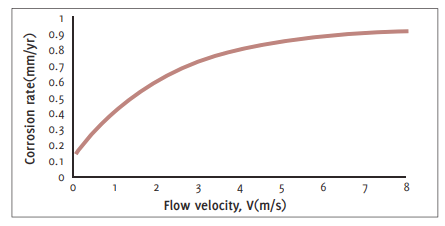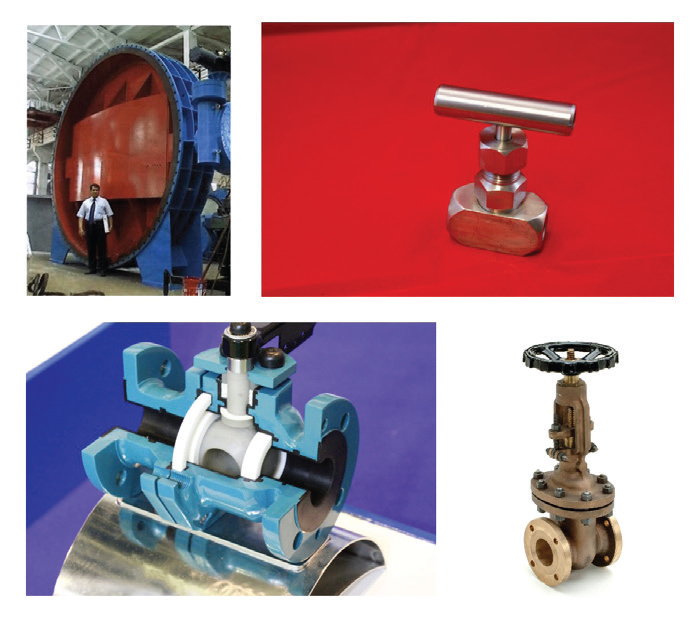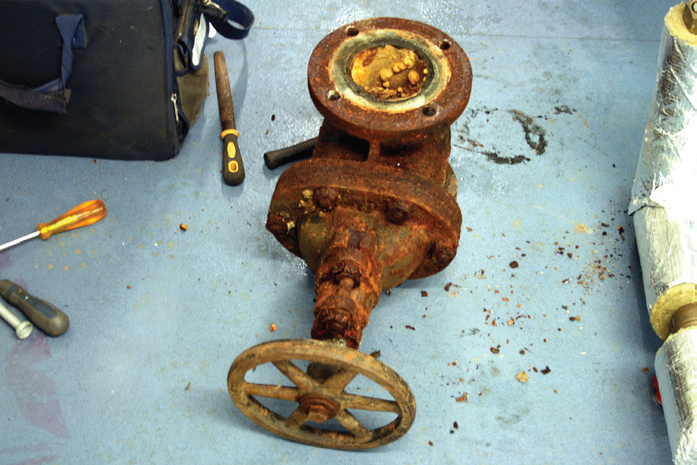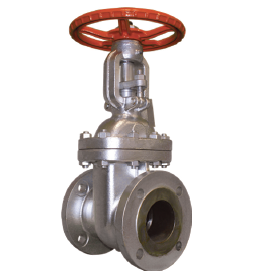Coatings are available which can provide suitable protection to valves and actuators, both internally and externally, in even the severest of applications.
By Prof. A. S. Khanna, Retd., IITBombay, Chairman SSPCIndia
A valve is a device that regulates, or controls the flow of a fluid (gases, liquids, or slurries) by opening, closing, or partially obstructing various passageways. In an open valve, fluid flows in a direction from higher pressure to lower pressure. Valves have many uses, including controlling water for irrigation, industrial uses for controlling processes, residential uses such as on/off and pressure control to dishwashers and washing machines for clothes as well as water taps in the home. Valves are also used in the military and transport sectors. In HVAC ductwork and other near-atmospheric air flows, the role of valves is more like a damper.
An actuator is a device that uses a form of power to convert a control signal into mechanical motion, for example, from electric door locks in automobiles, to ailerons on aircraft. A few types of actuators include electric motors, stepper motors, electroactive polymers, screw jacks, servomechanism, solenoids, and hydraulic cylinders. Therefore, it can be said that a valve is a physical part of a system that opens and closes to dictate the amount of fluid being allowed to pass through, while the actuator tells the valve when to operate.
There are numerous applications of valves, ranging from water and sewage processing, mining, power generation, processing of oil, gas and petroleum, food manufacturing, chemical and plastic manufacturing and many others. In daily use, valves are used for plumbing, such as taps for tap water, gas control valves on cookers, small valves fitted to washing machines and dishwashers, safety devices fitted to hot water systems, and poppet valves in car engines.
Valves may be operated manually, either by a handle, lever, pedal, or wheel. Valves may also be automatic, driven by changes in pressure, temperature, or flow. These changes may act upon a diaphragm or a piston which in turn activates the valve, examples of this type of valve found commonly are safety valves fitted to hot water systems or boilers.
Valves can be categorized into the following types, based on their operating mechanism:
- Ball valve, for on–off control without pressure drop. Ideal for quick shut-off.
- Butterfly valve, for on–off flow control in large diameter pipes.
- Diaphragm valve or membrane valve, controls flow by movement of a diaphragm.
- Gate valve, mainly for on–off control, with low pressure drop.
- Globe valve, good for regulating flow. Uses a cylinder movement over a seat.

- Knife valve, similar to a gate valve, but usually more compact.
- Needle valve, for accurate flow control.
- Pinch valve, for slurry flow regulation and control.
- Piston valve, for regulating fluids that carry solids in suspension.
- Plug valve, often used for on–off control but with some pressure drop.
- Solenoid valve, an electrically actuated valve for hydraulic or pneumatic fluid control.
Why do Valves Need Paint Coatings?
Valves are often used in flow systems that contain toxic liquids or gases, perhaps re- active chemicals, flammable petroleum, high-pressure steam, or compressed air. Usually, valves are made from steel as it is the cheapest material and is very easy to cast or machine into various intricate shapes. However, various other materials are also used to cast valves. Some of the common materials are carbon steel, ductile iron and cast iron, stainless steels, brass and bronzes, plastics such as PVC. Carbon steel is the cheapest material, easily available and easy to fabricate in any shape or form. However, it has a strong tendency to corrode in even moist environments and can corrode heavily in aggressive environments such as onshore and offshore. Thus, alternative materials such as stainless steels, and bronze, etc. are used. Plastic valves are also becoming very popular, and they are free from any corrosion.

Corrosion of the valve is basically the deterioration of valve material due to corrosive fluid as well as due to its flow rate. Corrosion of valve occurs both from the inside as well from outside. Internal corrosion is mainly due to two reasons: corrosive fluid and its flow rate. Figure 2 shows how the flow rate affects the corrosion rate of the pipe material from inside. External corrosion of valve is equally important and occurs mainly from the high humidity and polluted environment or from the vapours released in the plant, specifically in chemical plants, petrochemical plants, or refineries, where gases such as SO2 and H2S will attack the valve surface and cause various forms of corrosion ranging from uniform, localized pitting and crevice, galvanic and stress corrosion cracking. External corrosion also occurs by the release of corrosive vapours from the leakage of valves.
Thus, paint coating is an ideal solution to protect the valves, both from the external and internal corrosion. Coatings protect the valve material from external corrosion and specialized hard coatings help the internal valve from erosion-corrosion.
Corrosion Protection Technologies
There are various kinds of valves available in the market with different corrosion protection technology. There is a good market with zinc coated valves. Zinc can either used as a primer to enhance the life of the valve by cathodic protection whilst zinc plated valves are well known for water and gas applications1 which may provide longer life. There are several kinds of paint coatings starting from alkyd to acrylic to epoxy which protect the external valve body from corrosion.
Two-component acrylic paint is used for valves that are exposed to atmospheric influences and UV. The coating meets all requirements in connection to excellent resistance to UV radiation, mechanical stress, and corrosion. Two component acrylic paint is used for valves exposed to atmospheric pollutants and UV. This coating can be used for all valves used in industrial applications involving high air humidity and aggressive atmospheres. Hard-rubber lining is a special coating used for valves in the chemical industry. It consists of a high-tech, premium- quality synthetic or natural rubber.

The strong adhesion of the material to cast iron is ensured by vulcanizing the rubber to the cast-iron substrate. The finished rubber lining is non-porous and exhibits great hardness as well as excellent chemical resistance. This coating is available e.g., as a lining for butterfly valves, the plunger valves, and slanted seated tilting-disk check valves.
Other superior quality valve coatings can be achieved by powder coating. Powder coating is an electrostatically applied coating on an oppositely biased valve body, followed by baking to achieve a finish consisting of a mixture of finely ground resin, pigments, and binders. Powder coatings have much longer durability and also have high flexibility. Powder coating is the standard technique for actuator casings, yokes, and cylinders, as well as for cast iron and carbon steel valve body assemblies.
In case of a valve used in a refinery, chemical or petrochemical plant, it must be coated with not less than an epoxy coating or further modified epoxy coatings such as Epoxy-modified by MIO, or glass flakes. They enhance the strength and durability of the coating and reduce the permeability providing longevity to the coated valve. In case the environment is very corrosive specialized coatings are used. Some of them are explained:
To take care of severe acidic or alkaline environment from pH 1-14 and also to stabilize the coating up to a temperature of 250°C, a nano-modified epoxy-based coating is available which can be applied either directly on the blasted surface or after partial cleaning using st2/st3.2 (st2/ st3 refers to SSPC methods of partial cleaning using wire brush, sandpapers or using power tools.) 2.
Teflon coating on valves is required whenever one wants to protect the valve from severe acidic vapours released from the plant as well as toxic fumes and leakage from valve to pipe joints. PTFE solenoid valves are commonly used in controlling and distributing processes, throughout OEM equipment for cleaning, mixing, blending, and etching. They are frequently used side-by-side with PTFE pumps, PTFE check valves and PTFE tubing, fittings, and other devices. Details for Teflon coating on ball-valves and vacuum valves can be seen in references.3, 4
Internal Coatings on Valves
Internal valve surfaces can suffer damage due to high flow rates of the fluid, which leads to the erosion of the surface. If, in addition, there are impurities in fluid such as chlorides, oxygen or sulphur, this erosion is combined with corrosion leading to severe erosion-corrosion. As an example, see Figure 3 for a propeller in a water pipeline. In the water industry, valves are exposed to considerable stress such as high-water pressures, extreme temperatures, desert, or tropical climates. Valves therefore need to be made of a suitable material, with perfect technology and quality needs to ensure that the valves function reliably even after decades of service.
Thus, the coating should be made either by a hard material with good corrosion resistance or it can be made with normal steel with a hard coating. Several hard coatings are available in the market. However, the coating Belzona 13215 is a two-part ceramic-filled epoxy coating designed to provide erosion and corrosion resistance of metal surfaces. This solvent-free epoxy coating has outstanding chemical resistance and thanks to its high compressive strength it can also be used to create a perfect shim.
This material is easy to mix and apply without the need for specialist tools and it cures at room temperature, eliminating the need for hot work. It has longterm erosion and corrosion protection, excellent bonding to almost any rigid surface including steel, aluminium, copper, brass, and glass reinforced plastics with high compressive strength and excellent resistance against a wide range of chemicals. It can be used for internal coating for centrifugal and positive displacement pumps, heat exchangers, water boxes, and tube sheets, butterfly and gate valves, fans and Kort nozzles. (Also known as a ducted propeller, a Kort nozzle is a marine propeller fitted with a non- rotating nozzle for enhanced efficiency.)

Thermal spray gives a wide selection of hard coating solutions for the valve industry. The careful selection of coating materials is integral to the valve design process. Extremely hard coatings, using tungsten carbide or ceramic compositions can be achieved. Thermal spray coatings produce wear and corrosion resistance in valves.
Friction fluctuation can also be brought under control using such coatings. Ceramic and cermet materials such as chromium oxide for hard-coating valves are used in the chemical processing sector, and tungsten carbide and similar materials are used for the oil & gas industries. Metal-to-metal coating solutions for ball and gate valves are used in the petrochemical industry. Though, there are several thermal spray processes such as flame and arc spray and plasma, excellent results have been achieved using specialized high velocity oxygen fuel systems (HVOF) to achieve a high hardness and pore-free coating. Carbides are generally used for oxidation resistance as well as erosion–corrosion resistance. Arc spray techniques are used for depositing the tungsten carbide on metals as a porous coating. The HVOF technique is also used for coatings which are hard and abrasion resistant.
Summary
Valves are essential elements of a flowing system, which deteriorate with time. External corrosion of the valves occurs due to severe environment, especially C4 and C5 and toxic vapours emitting from chemical, petrochemical plants, or refineries. C1, C2, C3 C4 and C5 are the various categories of the extent of corrosion as per ISO classifications. Internal surface damage of the valves occurs due to erosion and corrosion as a result of the change in flow pattern as well as impurities present in the fluid. In order to avoid erosion and corrosion, one can either choose a material with high hardness and wear resistance or can create coatings which provide wear and corrosion resistance. There are a variety of coatings available ranging from simple alkyd, acrylic coatings for C1 and C2 environments to high performance coatings from simple epoxy to modified epoxy, Teflon and many other for the protection of external surface. For internal surface, both corrosion resistance and hardness of the coating is important.
References:
- Zinc plated ball-valves for water and gas, https:// www.ehp-eg.com/wp-content/ uploads/LD-Swift.pdf
- A. S. Khanna, Functional Coatings, Valve World –India and Middle East, Issue No. 27, May 2023.
- https://www.indiamart.com/proddetail/te_ on-coating- of-ball-valves-1852712555.html
- https://www.htcvacuum.com/en-global/vacuum- valves/te_ on-coating-vacuumvalve
- Belazone 1321, www.belzona. Publication No. 04-04-15-01.



